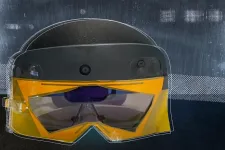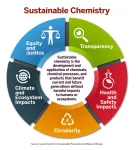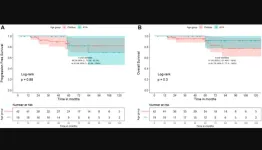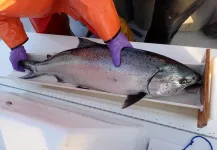(Press-News.org) MIT researchers have built an augmented reality headset that gives the wearer X-ray vision.
The headset combines computer vision and wireless perception to automatically locate a specific item that is hidden from view, perhaps inside a box or under a pile, and then guide the user to retrieve it.
The system utilizes radio frequency (RF) signals, which can pass through common materials like cardboard boxes, plastic containers, or wooden dividers, to find hidden items that have been labeled with RFID tags, which reflect signals sent by an RF antenna.
The headset directs the wearer as they walk through a room toward the location of the item, which shows up as a transparent sphere in the augmented reality (AR) interface. Once the item is in the user’s hand, the headset, called X-AR, verifies that they have picked up the correct object.
When the researchers tested X-AR in a warehouse-like environment, the headset could localize hidden items to within 9.8 centimeters, on average. And it verified that users picked up the correct item with 96 percent accuracy.
X-AR could aid e-commerce warehouse workers in quickly finding items on cluttered shelves or buried in boxes, or by identifying the exact item for an order when many similar objects are in the same bin. It could also be used in a manufacturing facility to help technicians locate the correct parts to assemble a product.
“Our whole goal with this project was to build an augmented reality system that allows you to see things that are invisible — things that are in boxes or around corners — and in doing so, it can guide you toward them and truly allow you to see the physical world in ways that were not possible before,” says Fadel Adib, who is an associate professor in the Department of Electrical Engineering and Computer Science, the director of the Signal Kinetics group in the Media Lab, and the senior author of a paper on X-AR.
Adib’s co-authors are research assistants Tara Boroushaki, who is the paper’s lead author; Maisy Lam; Laura Dodds; and former postdoc Aline Eid, who is now an assistant professor at the University of Michigan. The research will be presented at the USENIX Symposium on Networked Systems Design and Implementation.
Augmenting an AR headset
To create an augmented reality headset with X-ray vision, the researchers first had to outfit an existing headset with an antenna that could communicate with RFID-tagged items. Most RFID localization systems use multiple antennas located meters apart, but the researchers needed one lightweight antenna that could achieve high enough bandwidth to communicate with the tags.
“One big challenge was designing an antenna that would fit on the headset without covering any of the cameras or obstructing its operations. This matters a lot, since we need to use all the specs on the visor,” says Eid.
The team took a simple, lightweight loop antenna and experimented by tapering the antenna (gradually changing its width) and adding gaps, both techniques that boost bandwidth. Since antennas typically operate in the open air, the researchers optimized it for sending and receiving signals when attached to the headset’s visor.
Once the team had built an effective antenna, they focused on using it to localize RFID-tagged items.
They leveraged a technique known as synthetic aperture radar (SAR), which is similar to how airplanes image objects on the ground. X-AR takes measurements with its antenna from different vantage points as the user moves around the room, then it combines those measurements. In this way, it acts like an antenna array where measurements from multiple antennas are combined to localize a device.
X-AR utilizes visual data from the headset’s self-tracking capability to build a map of the environment and determine its location within that environment. As the user walks, it computes the probability of the RFID tag at each location. The probability will be highest at the tag’s exact location, so it uses this information to zero in on the hidden object.
“While it presented a challenge when we were designing the system, we found in our experiments that it actually works well with natural human motion. Because humans move around a lot, it allows us to take measurements from lots of different locations and accurately localize an item,” Dodds says.
Once X-AR has localized the item and the user picks it up, the headset needs to verify that the user grabbed the right object. But now the user is standing still and the headset antenna isn’t moving, so it can’t use SAR to localize the tag.
However, as the user picks up the item, the RFID tag moves along with it. X-AR can measure the motion of the RFID tag and leverage the hand-tracking capability of the headset to localize the item in the user’s hand. Then it checks that the tag is sending the right RF signals to verify that it is the correct object.
The researchers utilized the holographic visualization capabilities of the headset to display this information for the user in a simple manner. Once the user puts on the headset, they use menus to select an object from a database of tagged items. After the object is localized, it is surrounded by a transparent sphere so the user can see where it is in the room. Then the device projects the trajectory to that item in the form of footsteps on the floor, which can update dynamically as the user walks.
“We abstracted away all the technical aspects so we can provide a seamless, clear experience for the user, which would be especially important if someone were to put this on in a warehouse environment or in a smart home,” Lam says.
Testing the headset
To test X-AR, the researchers created a simulated warehouse by filling shelves with cardboard boxes and plastic bins, and placing RFID-tagged items inside.
They found that X-AR can guide the user toward a targeted item with less than 10 centimeters of error — meaning that on average, the item was located less than 10 centimeters from where X-AR directed the user. Baseline methods the researchers tested had a median error of 25 to 35 centimeters.
They also found that it correctly verified that the user had picked up the right item 98.9 percent of the time. This means X-AR is able to reduce picking errors by 98.9 percent. It was even 91.9 percent accurate when the item was still inside a box.
“The system doesn’t need to visually see the item to verify that you’ve picked up the right item. If you have 10 different phones in similar packaging, you might not be able to tell the difference between them, but it can guide you to still pick up the right one,” Boroushaki says.
Now that they have demonstrated the success of X-AR, the researchers plan to explore how different sensing modalities, like WiFi, mmWave technology, or terahertz waves, could be used to enhance its visualization and interaction capabilities. They could also enhance the antenna so its range can go beyond 3 meters and extend the system for use by multiple, coordinated headsets.
“Because there isn’t anything like this today, we had to figure out how to build a completely new type of system from beginning to end,” says Adib. “In reality, what we’ve come up with is a framework. There are many technical contributions, but it is also a blueprint for how you would design an AR headset with X-ray vision in the future.”
###
Written by Adam Zewe, MIT News Office
END
Augmented reality headset enables users to see hidden objects
The device could help workers locate objects for fulfilling e-commerce orders or identify parts for assembling products.
2023-02-27
ELSE PRESS RELEASES FROM THIS DATE:
How common is face blindness?
2023-02-27
How Common Is Face Blindness?
Study suggests condition affects more people than previously thought
For Immediate Release
Media Contacts:
Dennis Nealon
Dennis_Nealon@hms.harvard.edu
508-494-6117
Ekaterina Pesheva
Ekaterina_Pesheva@hms.harvard.edu
617-432-0441
At a Glance:
Study by researchers at Harvard Medical School/VA Boston Healthcare System suggests that face blindness lies on a continuum and may be more common than currently believed.
The study found similar face matching performance between prosopagnosics diagnosed with stricter vs. looser criteria, suggesting that the diagnostic criteria should be expanded.
As many as ...
Midwifery care safe for moderate- and high-risk pregnancies
2023-02-27
New UBC research shows that midwives in British Columbia are providing safe primary care for pregnancies of all medical risk levels, contrary to a popular belief that midwives mostly manage low-risk pregnancies.
The study, published in the Canadian Medical Association Journal, examined a decade of births in B.C. between 2008 and 2018. The researchers compared birth outcomes for people who had a midwife as their most responsible provider (MRP), with those who were cared for by a family physician or obstetrician.
The findings reveal that people who had a ...
Sustainable chemistry experts create blueprint for safer future
2023-02-27
Feb. 27, 2023
Media contacts:
Emily Gowdey-Backus, director of media relations, Emily_GowdeyBackus@uml.edu
Nancy Cicco, assistant director of media relations, Nancy_Cicco@uml.edu
Sustainable chemistry experts create blueprint for safer future
Group to share its work during free UMass Lowell webinar on March 1
Toxic chemicals – which pop up in everything from household cleaners and appliances to medical devices, paints, packaging and more – are all around. The February ...
Early-life stress can disrupt maturation of brain’s reward circuits, promoting disorders
2023-02-27
Irvine, Calif., Feb. 27, 2023 — A new brain connection discovered by University of California, Irvine researchers can explain how early-life stress and adversity trigger disrupted operation of the brain’s reward circuit, offering a new therapeutic target for treating mental illness. Impaired function of this circuit is thought to underlie several major disorders, such as depression, substance abuse and excessive risk-taking.
In an article recently published online in Nature Communications, Dr. Tallie Z. Baram, senior author and UCI Donald Bren Professor and Distinguished Professor in the Departments of Anatomy & Neurobiology, ...
Cedars-Sinai’s efforts to combat lower back pain get $2 million boost from CIRM
2023-02-27
Investigators at Cedars-Sinai have received a $2 million grant from the California Institute for Regenerative Medicine (CIRM) to develop a new cell therapy that helps improve quality of life for patients with degenerated discs and chronic lower back pain.
Dmitriy Sheyn, PhD, assistant professor in the departments of Orthopaedics, Surgery and Biomedical Sciences at Cedars-Sinai leads this new project in collaboration with Debiao Li, PhD, director of the Biomedical Imaging Research Institute and professor of Biomedical Sciences and Imaging at Cedars-Sinai; and Hyun Bae, MD, professor of Orthopaedics and co-medical ...
Amazon develops algorithm to improve collaboration between robots and humans
2023-02-27
New Study Key Takeaways:
A new algorithm is identified to allow robots and humans to work together efficiently and profitably.
Robots bring shelves of inventory to associates to pick for customer orders.
The adoption of the algorithm cuts down on distance traveled by pods as well as the storage footprint for the company.
The fulfillment operation with the new algorithm results in a half a billion dollars in savings.
BALTIMORE, MD, February 27, 2023 – Amazon has identified a financially beneficial way for robots and humans to coexist, and it’s saving the online enterprise half a billion dollars per year. Using robots to bring ...
Oncotarget | WNT-pathway medulloblastoma: What constitutes low-risk and how low can one go?
2023-02-27
“The definition of low-risk WNT-pathway medulloblastoma may need to be refined in light of recent clinical data and newer biological information.”
BUFFALO, NY- February 27, 2023 – A new research perspective was published in Oncotarget's Volume 14 on February 7, 2023, entitled, “WNT-pathway medulloblastoma: what constitutes low-risk and how low can one go?”
Novel biological insights have established that medulloblastoma is a heterogenous disease comprising four broad molecular subgroups - WNT, SHH, Group 3, and Group 4 respectively, resulting in the incorporation of molecular/genetic information in 5th edition ...
Rutgers researchers use artificial intelligence to predict cardiovascular disease
2023-02-27
Researchers may be able to predict cardiovascular disease – such as arterial fibrillation and heart failure – in patients by using artificial intelligence (AI) to examine the genes in their DNA, according to a new Rutgers study.
“With the successful execution of our model, we predicted the association of highly significant cardiovascular disease genes tied to demographic variables like race, gender and age.” said Zeeshan Ahmed, a core faculty member at the Rutgers Institute for Health, Health Care Policy and Aging ...
To promote exercise, planners must look beyond cities
2023-02-27
ITHACA, N.Y. – To encourage more active lifestyles, public health agencies recommend mixed-use neighborhoods and “complete” streets that are friendlier to walkers and bikers, but new Cornell University research finds that while those strategies increase physical activity, an urban bias limits their applicability in many parts of the country.
Planners in suburban and rural communities should focus more on promoting recreational programs, expanding transportation options and creating safer environments to help an aging population get more exercise, according to the researchers’ analysis of more than 1,300 U.S. counties and cities.
“These ...
Shrinking age distribution of spawning salmon raises climate resilience concerns
2023-02-27
By returning to spawn in the Sacramento River at different ages, Chinook salmon lessen the potential impact of a bad year and increase the stability of their population in the face of climate variability, according to a new study by scientists at UC Santa Cruz and NOAA Fisheries.
Unfortunately, spawning Chinook salmon are increasingly younger and concentrated within fewer age groups, with the oldest age classes of spawners rarely seen in recent years. The new study, published February 27 in the Canadian Journal of Fisheries and Aquatic Sciences, suggests changes in hatchery practices and fishery management ...
LAST 30 PRESS RELEASES:
Heart-brain connection: international study reveals the role of the vagus nerve in keeping the heart young
Researchers identify Rb1 as a predictive biomarker for a new therapeutic strategy in some breast cancers
Survey reveals ethical gaps slowing AI adoption in pediatric surgery
Stimulant ADHD medications work differently than thought
AI overestimates how smart people are, according to HSE economists
HSE researchers create genome-wide map of quadruplexes
Scientists boost cell "powerhouses" to burn more calories
Automatic label checking: The missing step in making reliable medical AI
Low daily alcohol intake linked to 50% heightened mouth cancer risk in India
American Meteorological Society announces Rick Spinrad as 2026 President-Elect
Biomass-based carbon capture spotlighted in newly released global climate webinar recording
Illuminating invisible nano pollutants: advanced bioimaging tracks the full journey of emerging nanoscale contaminants in living systems
How does age affect recovery from spinal cord injury?
Novel AI tool offers prognosis for patients with head and neck cancer
Fathers’ microplastic exposure tied to their children’s metabolic problems
Research validates laboratory model for studying high-grade serous ovarian cancer
SIR 2026 delivers transformative breakthroughs in minimally invasive medicine to improve patient care
Stem Cell Reports most downloaded papers of 2025 highlight the breadth and impact of stem cell research
Oxford-led study estimates NHS spends around 3% of its primary and secondary care budget on the health impacts of heat and cold in England
A researcher’s long quest leads to a smart composite breakthrough
Urban wild bees act as “microbial sensors” of city health.
New study finds where you live affects recovery after a hip fracture
Forecasting the impact of fully automated vehicle adoption on US road traffic injuries
Alcohol-related hospitalizations from 2016 to 2022
Semaglutide and hospitalizations in patients with obesity and established cardiovascular disease
Researchers ‘listen in’ to embryo-mother interactions during implantation using a culture system replicating the womb lining
How changing your diet could help save the world
How to make AI truly scalable and reliable for real-time traffic assignment?
Beyond fragmented markets: A new framework for efficient and stable ride-pooling
Can shape priors make road perception more reliable for autonomous driving?
[Press-News.org] Augmented reality headset enables users to see hidden objectsThe device could help workers locate objects for fulfilling e-commerce orders or identify parts for assembling products.



